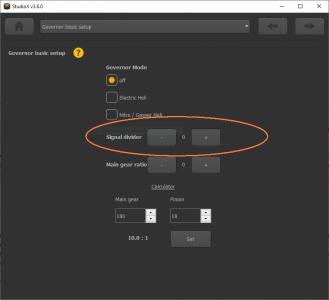Manuals:MBPlusFblV52:Governormenu E/de: Difference between revisions
Shornstein (talk | contribs) Created page with "GOVERNORMENÜ E - Teilungsfaktor des Drehzahlsignals" |
Shornstein (talk | contribs) Imported translation using page migration |
||
| (11 intermediate revisions by 2 users not shown) | |||
| Line 1: | Line 1: | ||
{{TOC_MBPlusV5/de|Manuals:MBPlusFblV52:Governormenu_D/de|Manuals:MBPlusFblV52:Governormenu_F/de|GOVMENU|2}} | |||
{{TOC_MBPlusV5|Manuals:MBPlusFblV52:Governormenu_D/ | |||
__TOC__ | __TOC__ | ||
<br /> | <br /> | ||
'''Elektromodell''': Der Phasensensor oder Drehzahlsteller gibt üblicherweise die elektrische Felddrehzahl aus und nicht die tatsächliche Motordrehzahl. Um die tatsächliche Motordrehzahl zu erhalten, muss die Felddrehzahl anhand der Polzahl des Motors umgerechnet werden.<br /> | |||
<br /> | <br /> | ||
{{QUOTE| | {{QUOTE|Die Polzahl eines Elektromotors lässt sich einfach ermitteln, indem man die Anzahl der Magnete zählt, die in der Motorglocke verbaut sind. Jeder Magnet entspricht einem Pol. Zu beachten ist, dass bei manchen Motoren Magnetpaare anstatt einzelner großer Magneten verbaut sind. Diese Paare bilden zusammen dann nur einen Magnetpol! Im Zweifel lies das Datenblatt des Motors oder frag den Motorhersteller oder Deinen Fachhändler.}}<br /> | ||
<br /> | <br /> | ||
'''Modelle mit Verbrennungsmotor''': Wenn ein Magnetsensor verbaut ist und mehr als ein Magnetgeber zur Messung der Drehzahl verwendet wird, so multipliziert sich die ausgegebene Drehzahl um die Anzahl der Magnete. Bei zwei Magneten wird der Sensor eine doppelt so hohe Drehzahl messen, als mit einem Magnet.<br /> | |||
<br /> | |||
{{QUOTE|Um bei einem Verbrennermodell die Anzahl der Magnete herauszufinden, die z.B. in der Kupplungsglocke verbaut sind, kann der Sensortest bei von Einstellpunkt A genutzt werden. Jedesmal wenn ein Magnet den Sensor passiert, wird dort die Status LED blau aufleuchten!}}<br /> | |||
<br /> | <br /> | ||
= | =Einstellung am Gerät= | ||
Bei Einstellpunkt E wird der momentan ausgewählte Teilungsfaktor durch die Farbe der Status LED dargestellt. Die Einstellung kann durch kurzes Antippen des Hecksteuerknüppels verändert werden.<br /> | |||
<br /> | <br /> | ||
{|cellpadding="4" cellspacing="0" border="1" style="text-align:center; margin:0px 0px 0px 20px | {|cellpadding="4" cellspacing="0" border="1" style="text-align:center; margin:0px 0px 0px 20px" | ||
!style="width:100px; text-align: | !style="width:100px; text-align:left;" | Status LED | ||
!style="width:400px;" | | !style="width:400px;" | Teilungsfaktor | ||
|- | |- | ||
|style="color:white; background-color:black; text-align:left;"| | |style="color:white; background-color:black; text-align:left;"|aus | ||
|''' | |'''keine Teilung'''<br />2 Motorpole (Elektro) oder 1 Magnet (Verbrenner) | ||
|- | |- | ||
|style="color:white; text-align:left; background: linear-gradient(to right, #CC66CC, black, #CC66CC)"| | |style="color:white; text-align:left; background: linear-gradient(to right, #CC66CC, black, #CC66CC)"|violett blinkend | ||
|'''2'''<br />4 | |'''2'''<br />4 Motorpole (Elektro) oder 2 Magnete (Verbrenner) | ||
|- | |- | ||
|style="color:white; text-align:left; background-color:#CC66CC"| | |style="color:white; text-align:left; background-color:#CC66CC"|violett | ||
|'''3'''<br />6 | |'''3'''<br />6 Motorpole (Elektro) oder 3 Magnete (Verbrenner) | ||
|- | |- | ||
|style="color:white; text-align:left; background: linear-gradient(to right, #FF3300, black, #FF3300)"| | |style="color:white; text-align:left; background: linear-gradient(to right, #FF3300, black, #FF3300)"|rot blinkend | ||
|'''4'''<br />8 | |'''4'''<br />8 Motorpole (Elektro) | ||
|- | |- | ||
|style="color:white; text-align:left; background-color:#FF3300"| | |style="color:white; text-align:left; background-color:#FF3300"|rot | ||
|'''5'''<br />10 | |'''5'''<br />10 Motorpole (Elektro) | ||
|- | |- | ||
|style="color:white; text-align:left; background: linear-gradient(to right, #0066FF, black, #0066FF)"| | |style="color:white; text-align:left; background: linear-gradient(to right, #0066FF, black, #0066FF)"|blau blinkend | ||
|'''6'''<br />12 | |'''6'''<br />12 Motorpole (Elektro) | ||
|- | |- | ||
|style="color:white; text-align:left; background-color:#0066FF"| | |style="color:white; text-align:left; background-color:#0066FF"|blau | ||
|'''7'''<br />14 | |'''7'''<br />14 Motorpole (Elektro) | ||
|}<br /> | |}<br /> | ||
<br /> | <br /> | ||
<br /> | <br /> | ||
= | =Einstellung mit StudioX= | ||
Wähle im Menü ''Drehzahlregelung Grundeinstellung'' den passenden Teilungsfaktor aus. '''Beachte beim Elektromodell, dass der Teilungsfaktor der halben Polzahl entspricht!''' Bei einem 10-pol Motor ist also z.B. der Faktor "5" auszuwählen. | |||
<br /> | <br /> | ||
<br /> | |||
[[File:govmenu_basic_setup_divider.png|x300px]]<br /> | |||
<br /> | <br /> | ||
Latest revision as of 23:03, 30 July 2022
Elektromodell: Der Phasensensor oder Drehzahlsteller gibt üblicherweise die elektrische Felddrehzahl aus und nicht die tatsächliche Motordrehzahl. Um die tatsächliche Motordrehzahl zu erhalten, muss die Felddrehzahl anhand der Polzahl des Motors umgerechnet werden.
Die Polzahl eines Elektromotors lässt sich einfach ermitteln, indem man die Anzahl der Magnete zählt, die in der Motorglocke verbaut sind. Jeder Magnet entspricht einem Pol. Zu beachten ist, dass bei manchen Motoren Magnetpaare anstatt einzelner großer Magneten verbaut sind. Diese Paare bilden zusammen dann nur einen Magnetpol! Im Zweifel lies das Datenblatt des Motors oder frag den Motorhersteller oder Deinen Fachhändler.
Modelle mit Verbrennungsmotor: Wenn ein Magnetsensor verbaut ist und mehr als ein Magnetgeber zur Messung der Drehzahl verwendet wird, so multipliziert sich die ausgegebene Drehzahl um die Anzahl der Magnete. Bei zwei Magneten wird der Sensor eine doppelt so hohe Drehzahl messen, als mit einem Magnet.
Um bei einem Verbrennermodell die Anzahl der Magnete herauszufinden, die z.B. in der Kupplungsglocke verbaut sind, kann der Sensortest bei von Einstellpunkt A genutzt werden. Jedesmal wenn ein Magnet den Sensor passiert, wird dort die Status LED blau aufleuchten!
Einstellung am Gerät
Bei Einstellpunkt E wird der momentan ausgewählte Teilungsfaktor durch die Farbe der Status LED dargestellt. Die Einstellung kann durch kurzes Antippen des Hecksteuerknüppels verändert werden.
| Status LED | Teilungsfaktor |
|---|---|
| aus | keine Teilung 2 Motorpole (Elektro) oder 1 Magnet (Verbrenner) |
| violett blinkend | 2 4 Motorpole (Elektro) oder 2 Magnete (Verbrenner) |
| violett | 3 6 Motorpole (Elektro) oder 3 Magnete (Verbrenner) |
| rot blinkend | 4 8 Motorpole (Elektro) |
| rot | 5 10 Motorpole (Elektro) |
| blau blinkend | 6 12 Motorpole (Elektro) |
| blau | 7 14 Motorpole (Elektro) |
Einstellung mit StudioX
Wähle im Menü Drehzahlregelung Grundeinstellung den passenden Teilungsfaktor aus. Beachte beim Elektromodell, dass der Teilungsfaktor der halben Polzahl entspricht! Bei einem 10-pol Motor ist also z.B. der Faktor "5" auszuwählen.
